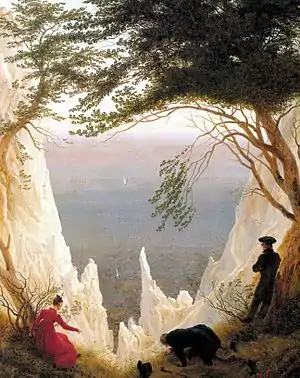Wanderer above the Sea of Fog
Wanderer above the Sea of Fog (German: Der Wanderer über dem Nebelmeer), also known as Wanderer above the Mist or Mountaineer in a Misty Landscape,[1] is an oil painting c. 1818[2] by the German Romantic artist Caspar David Friedrich. It has been considered one of the masterpieces of Romanticism and one of its most representative works. It resides in the Kunsthalle Hamburg, Germany.
| Wanderer above the Sea of Fog | |
|---|---|
 | |
| Artist | Caspar David Friedrich |
| Year | c. 1818 |
| Medium | Oil-on-canvas |
| Dimensions | 94.8 cm × 74.8 cm (37.3 in × 29.4 in) |
| Location | Kunsthalle Hamburg, Hamburg, Germany |
Description
In the foreground, a young man stands upon a rocky precipice with his back to the viewer. He is wrapped in a dark green overcoat, and grips a walking stick in his right hand.[3] His hair caught in a wind, the wanderer gazes out on a landscape covered in a thick sea of fog. In the middle ground, several other ridges, perhaps not unlike the ones the wanderer himself stands upon, jut out from the mass.[4] Through the wreaths of fog, forests of trees can be perceived atop these escarpments. In the far distance, faded mountains rise in the left, gently leveling off into lowland plains in the right. Beyond here, the pervading fog stretches out indefinitely, eventually commingling with the horizon and becoming indistinguishable from the cloud-filled sky.[3]
The painting is composed of various elements from the Elbe Sandstone Mountains in Saxony and Bohemia, sketched in the field but in accordance with his usual practice, rearranged by Friedrich himself in the studio for the painting. In the background to the right is the Zirkelstein. The mountain in the background to the left could be either the Rosenberg or the Kaltenberg. The group of rocks in front of it represent the Gamrig near Rathen. The rocks on which the traveler stands are a group on the Kaiserkrone.[5]
Commentary
Wanderer above the Sea of Fog is true to the Romantic style and Friedrich's style in particular,[6] being similar to other works such as Chalk Cliffs on Rügen and The Sea of Ice. Gorra's (2004) analysis was that the message conveyed by the painting is one of Kantian self-reflection, expressed through the wanderer's gazings into the murkiness of the sea of fog.[4] Dembo (2001) sympathised, asserting that Wanderer presents a metaphor for the unknown future.[7] Gaddis (2004) felt that the impression the wanderer's position atop the precipice and before the twisted outlook leaves "is contradictory, suggesting at once mastery over a landscape and the insignificance of the individual within it".[3]
With the composition of the figure's back placed towards the observer otherwise known as Rückenfigur,[8] it allows the observer to gain insight into Friedrich's experience.[9] Friedrich himself states his ideas in regards to this, "The artist should paint not only what he has in front of him but also what he sees inside himself."[10]
Some meaning of this work is lost in the translation of its title. In German, the title is "Wanderer über dem Nebelmeer". Wanderer in German can mean either "wanderer" or "hiker".[11]
Robert Macfarlane discusses the painting in terms of its significant influence on how mountain climbing has been viewed in the Western world since the Romantic era, calling it the "archetypical image of the mountain-climbing visionary", and describing its power in representing the concept that standing on mountain tops is something to be admired, an idea which barely existed in earlier centuries.[12]
The image has been used on the cover of numerous books, as a signifier of romanticism, horror, mystery, or other evocative emotions.[13]
In popular culture
- Part of Wanderer above the Sea of Fog can be seen in the sandbox video game Minecraft as an in-game painting.[14]
- Stewart Lee, the English comedian, recreated the painting in his Content Provider [15] tour in 2016. Criticising his audience as “inward-looking, self-obsessed people with no attention span” in the age of social media, he finishes by contrasting the figure in Wanderer above the Sea of Fog to the narcissistic selfie-takers of today.
- Celine Sciamma's 2019 drama Portrait of a Lady on Fire references 'Wanderer above the Sea of Fog' in one of the scenes where the protagonist Héloïse looks out to the sea, a shot also used as a poster design for the film. The framing, lighting, and character's position as well as the rocks, sea spray, and beach are among the key parallels, rendering the reference particularly distinctive. [16]
References
- Arts Council of Great Britain (1959). The romantic movement. Fifth exhibition to celebrate the tenth anniversary of the Council of Europe, 10 July to 27 September 1959, the Tate Gallery and the Arts Council Gallery, London. Hathi Trust. Arts Council of Great Britain.
- Exhibition Catalogue: Caspar David Friedrich. Die Underling der Romantic in Essen ind Hamburg, Firmer Verlag, München (December 2006), page 267
- Gaddis, John Lewis (2004). "The Landscape of History". The Landscape of History: How Historians Map the Past. Oxford University Press. pp. 1–2. ISBN 0-19-517157-8.
- Gorra, Michael Edward (2004). The Bells in Their Silence: Travels Through Germany. Princeton University Press. pp. 11-12. ISBN 0-691-11765-9. JSTOR j.ctt7sr5d.
- Hoch, Karl-Ludwig (1987). Caspar David Friedrich und die böhmischen Berge. Dresden: Kohlhammer Verlag. p. 215. ISBN 9783170094062.
- Gunderson, Jessica (2008). Romanticism. The Creative Company. p. 7. ISBN 978-1-58341-613-6.
- Dembo, Ron S.; Freeman, Andrew (January 19, 2001). The Rules of Risk: A Guide for Investors. Wiley. p. 10. ISBN 0-471-40163-3.
- Koerner, Joseph Leo (2009). Caspar David Friedrich and the Subject of Landscape (2nd ed.). Reaktion Books. ISBN 978-1-8618-9750-3.
- "Wanderer above the Sea of Fog". Artble.
- “Wanderer Above the Sea of Fog, Caspar David Friedrich (Ca. 1817).” Scholastic Art
- Black, Joseph; Conolly, Leonard; Flint, Kate; Grundy, Isobel; LePan, Don; Liuzza, Roy; McGann, Jerome J.; Prescott, Anne Lake; Qualls, Barry V.; Waters, Claire (July 23, 2010). The Broadview Anthology of British Literature: The Age of Romanticism. 4 (2nd ed.). Broadview Press. p. 1056. ISBN 978-1-55111-404-0.
- Macfarlane, Robert (2003). Mountains of the Mind: A History of a Fascination. Granta Books. p. 157. ISBN 9781847080394.
- "Wanderers Above the Sea of Fog (25 books)". www.goodreads.com. Retrieved 2020-09-15.
- "Painting". Minecraft Wiki. Retrieved 2020-10-18.
- Stewart Lee. Content Provider (PAL) (DVD). The Media Garage.
- "Wanderer above the Sea of Fog (c. 1818) Portrait of a Lady on Fire (2019)". Veronica Bloomsbury Pinterest. Retrieved 2020-11-10.
External links
![]() Media related to Der Wanderer über dem Nebelmeer at Wikimedia Commons
Media related to Der Wanderer über dem Nebelmeer at Wikimedia Commons
- Wanderer above the Sea of Fog Analysis
- Sketches for the painting (in German)
- Idrobo, Carlos (November 2012). "He Who Is Leaving ... The Figure of the Wanderer in Nietzsche's Also sprach Zarathustra and Caspar David Friedrich's Der Wanderer über dem Nebelmeer". Nietzsche-Studien. 41 (1): 78–103. doi:10.1515/niet.2012.41.1.78. S2CID 155017448. (Online) (Print).
